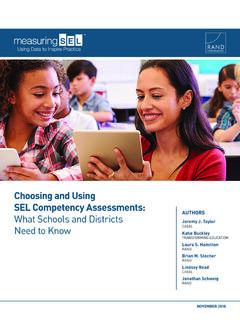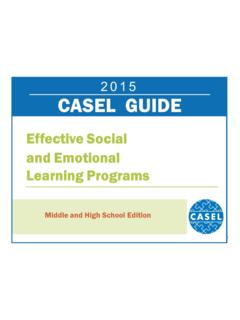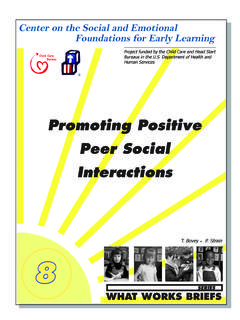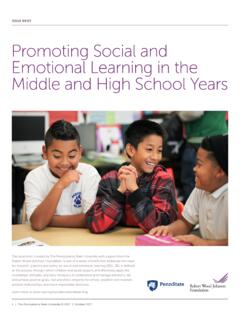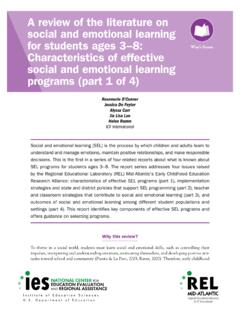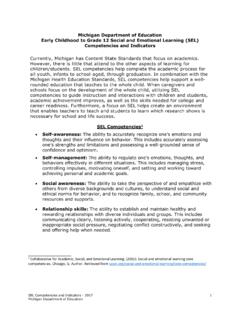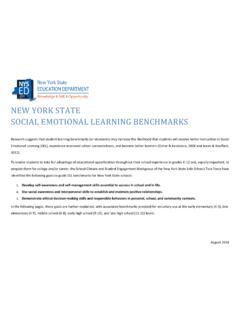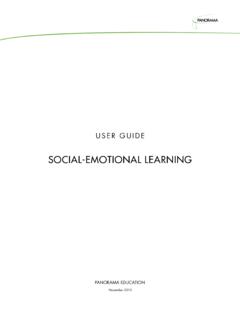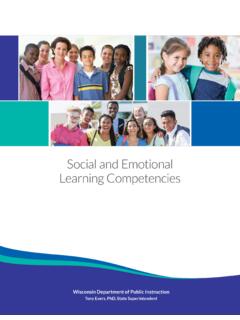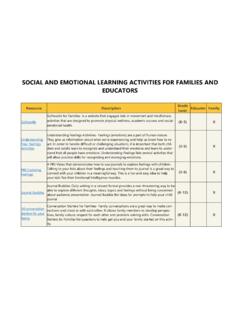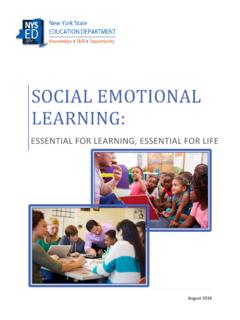Transcription of Equity & Social and Emotional Learning: A Cultural Analysis
1 Establishing Practical Social - Emotional Competence Assessments Work Group November 2018 AUTHORR obert J. JagersCASELD eborah Rivas-DrakeUniversity of MichiganTeresa BorowskiUniversity of Illinois at ChicagoEquity & Social and Emotional learning : A Cultural Analysis PurposeSocial and Emotional learning (SEL) has the potential to help mitigate the interrelated legacies of racial and class oppression in the and globally. Currently, that potential is under-realized. In this brief, we outline how CASEL s core SEL competencies reflect issues of Equity , highlight programs and practices that support the development of these competencies to promotes educational Equity , and offer some implications for the growing demand for SEL assessments. This brief is part of our initial efforts to analyze, revise, and supplement what is known about SEL to foster the development of citizens who contribute to an increasingly interconnected, diverse global community.
2 SEL refers to a process through which children and adults acquire and effectively apply the knowledge, attitudes, and skills necessary to understand and manage emotions; set and achieve positive goals; feel and show empathy for others; establish and maintain positive relationships; and make responsible decisions. Mounting evidence of the positive impacts of SEL programs has prompted practitioners, researchers, and policymakers to advocate for the adoption of such programs1. However, questions have been raised about whether guiding frameworks, prominent programs, and associated assessments adequately reflect, cultivate, and leverage Cultural assets and promote the well-being of youth of color and those from under-resourced Equity means that every student has access to the resources and educational rigor they need at the right moment in their education regardless 1 Jones, & Kahn, J.
3 (2017). The Evidence Base for How We Learn Supporting Students Social , Emotional , and Academic Development. National Commission on Social , Emotional , and Academic Development. Washington, DC: The Aspen Institute 2 Castro-Olivo, S. M. (2014). Promoting Social - Emotional learning in adolescent Latino ELLs: A study of the culturally adapted Strong Teens Program. School Psychology Quarterly, 29(4): 567-577; AspenInstitute Education & Society (2018). Pursuing Social and Emotional Development Through a Racial Equity Lens: A Call to Action. Washington, DC FRAMEWORKS BRIEFS special issues series NOVEMBER 2018 Establishing Practical Social - Emotional Competence Assessments Work Group page 2of race, gender, ethnicity, language, disability, family background, or family income.
4 Striving for educational Equity challenges us to examine biases and interrupt inequitable practices so we can create inclusive, multicultural school environments that cultivate the interests and talents of children, youth, and adults from diverse the Social , Emotional , and academic needs of youth from these historically marginalized groups is a pressing matter. According to current projections, the will be a minority-majority nation in less than three decades4. An increasing number of school-aged children and youth reside in poor or low-income families and communities. Racial/ethnic and class inequalities in education, health, and wealth compromise the life chances of these youth, which ultimately undermines the vitality of their communities and threatens the nation s security and productivity.
5 As such, we ask: How can SEL be leveraged to help youth from historically marginalized race/ethnic and socioeconomic groups to realize their fullest potential as contributing members of an increasingly complex and diverse global community?Below, we examine the Cultural and historical context for understanding the relationship between SEL and Equity , and then explore prospects for Equity elaborations to the CASEL five core competencies. Next, we point to programs and practices that can help cultivate these competencies and the importance of adult professional development in making these efforts maximally effective for diverse children and youth. We conclude with some implications for SEL assessment. We recognize that the circumstances surrounding marginalization, exploitation, and oppression are varied and complex.
6 In this brief, we focus primarily on issues of educational Equity and SEL with regard to race/ethnicity and socioeconomic status as a first step toward addressing this complexity. How Did We Get Here? Situating Equity and SEL in a Cultural and Historical ContextRacial/ethnic and class issues continue to vex American society. Cultural Analysis suggests that is-sues of racism derive largely from an over-emphasis on the accumulation of wealth within American culture5. Historically, this Cultural value prompted some to exploit others for personal advancement. White elites promulgated racialized and Cultural stereotypes to recruit poor and working Whites into a hierarchical economic system that exploited them, but also empowered them to oppress and fur-ther exploit people of color.
7 Meanwhile, these stereotypes inculcated within people of color a sense of dehumanization and willingness to accept marginalized status6. Many current economic, health, and educational inequities can be understood as remnants and vari-3 Aspen Education & Society Program and the Council of Chief State School Officers. 2017. Leading for Equity : Opportunities for State Education Chiefs. Washington, ; National Equity Project. ( ). 4 Census Bureau (2014). Washington DC. 5 Watson, D. C. (2016). Dominance and prestige in materialism. North American Journal of Psychology, 18(2): 359-376. 6 Allen, (2012). Invention of the White race (2nd edition): New York: Verso. FRAMEWORKS BRIEFS special issues series NOVEMBER 2018ants of this foundational set of political, Social , and psychological arrangements.
8 Therefore, it is critical to consider issues of Equity and SEL against the backdrop of these historical and contemporary racial/ethnic and socioeconomic tensions and and SEL: Toward Transformative Social and Emotional learning Promoting the optimal development of all students, especially preK-12 students who have historically been under-served, can be a contentious, complex, and long-term undertaking. But it is one that benefits all. Given the prominence of the CASEL frame-work and its attention to citizenship as a long-term develop-mental imperative, there is heuristic and practical value in viewing children and youth as the next generation of informed, engaged, and justice-oriented citizens. Consistent with the pursuit of educational Equity , we recently offered the concept of transformative SEL to reflect our interest in making explicit issues such as power, privilege, prejudice, discrimination, Social justice, empowerment, and self-determination in the field of SEL7.
9 Transformative SEL connotes a process whereby students and teachers build strong, respectful relationships founded on an appre-ciation of similarities and differences, learn to critically examine root causes of inequity, and develop collaborative solutions to community and societal problems. The CASEL 5 competencies through an Equity lens The CASEL 5 SEL competencies (figure 1) of self-awareness, self-manage- ment, Social awareness, relationship skills, and responsible decision- making represent large categories for organizing a range of intra- and interpersonal knowledge, skills, and abilities8. We view these competen- cies as interrelated, synergistic, and integral to the growth and develop- ment of justice-oriented, global citizens. Below, we consider each competency through an Equity lens what we refer to as Equity elaborations.
10 SELF-AWARENESS. Self-awareness encompasses individual psychologi-cal characteristics such as labeling one s feelings, relating feelings and thoughts to behavior, accurate self-assessment of strengths and challenges, self-efficacy, and Jagers, (2016). Framing Social and Emotional learning among African-American youth: Toward an integrity-based approach. Human Development, 59, 1-3. 8 Weissberg, R. P., Durlak, , Domitrovich, & Gullotta, (2015). Social and Emotional learning : Past, present and future. In Durlak, Domitrovich, Weissberg and Gullotta (Eds.), Handook of Social and Emotional learning : Research and practice (pp. 3-19). New York, NY: Guilford Press. Establishing Practical Social - Emotional Competence Assessments Work Group page 3 FRAMEWORKS BRIEFS special issues series NOVEMBER 2018 TRANSFORMATIVE SEL CONNOTES A PROCESS WHEREBY STUDENTS AND TEACHERS BUILD STRONG, RESPECTFUL RELATIONSHIPS FOUNDED ON AN APPRECIA-TION OF SIMILARITIES AND DIFFERENCES, LEARN TO CRITICALLY EXAMINE ROOT CAUSES OF INEQUITY, AND DEVELOP COLLABORATIVE SOLUTIONS TO COMMUNITY AND SOCIETAL PROBLEMS.

